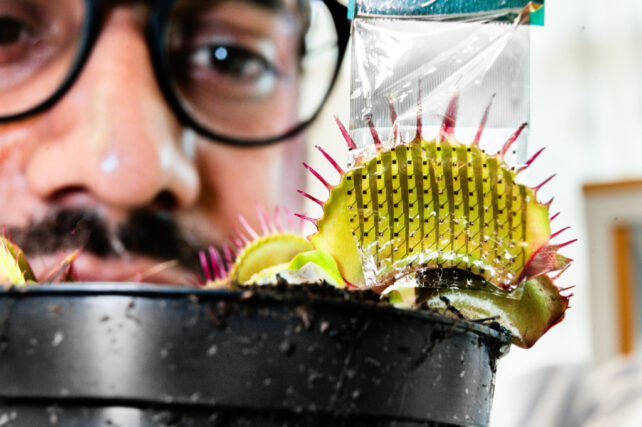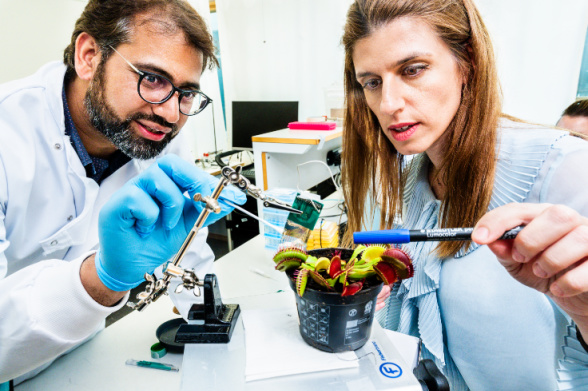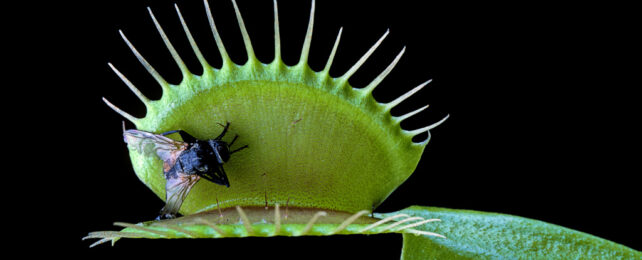Venus flytraps (Dionaea muscipula) are some of the most ferocious plants on Earth. These carnivorous plants appear most fearsome in the moments before they pounce, when they are poised to ensnare their prey.
Fangs agape, the Venus flytrap waits. Until an insect or spider tickles one of its sensory hairs – once, twice – then the plant strikes, snapping shut to devour the intruder.
Now, the electrical signals triggering that deadly move have been mapped in Venus flytraps for the first time, by a team of researchers led by bioelectronics researcher Eleni Stavrinidou of Linköping University in Sweden.
"So far these signals have been resolved with single electrodes that cannot give precise information on how the signals propagate" or where they originate, Stavrinidou tells ScienceAlert.
Just a few years ago, plant scientists figured out that two, successive brushes of the flytraps' sensory hairs trigger a surge of charged calcium ions inside the plants' leaves before they snap shut. But those studies only resolved plant cell signaling in broad strokes.
"Our study is the first to map these signals" across the leaves of Venus flytraps, Stavrinidou says, "but more studies are required to fully understand their propagation."

Like in human cells, an influx of calcium ions creates an action potential that spreads along and between the plant's cells. Although plants have no nervous system, these quick bursts of electrical activity are eerily similar to the electrical impulses of our nerve cells firing.
Along with calcium ions, potassium and chlorine ions rush into plant cells via ion channels, creating a momentary charge imbalance that travels along cells, creating an electrical signal.
To measure and map these signals in D. muscipula, the researchers developed a flexible thin-film sensor threaded with electrodes that could wrap around the plant's outstretched lobes. They poked the plant's sensory hairs and filmed its movements, all while recording the electrical impulses generated.

The recordings reveal how electrical signals in Venus flytraps radiate out at a constant speed from tripped sensory hairs, triggering the trap to close if hairs were touched twice within about 30 seconds.
If hairs were prodded more than 1 minute apart, the second signal moved faster than the first, as if the plant was still on guard.
Unexpectedly, though, the team found some electrical signals spontaneously originated from unstimulated hairs, as the trap was closing.
"This is very interesting," Stavrinidou says, but "we don't know yet why this happens or what the function is."
It's well known that plants send electrical signals when wounded by leaf-munching herbivores or attacked at the roots, and can even respond to light touch. Stavrinidou and colleagues similarly recorded electrical signals emanating from wounded tissues, not just sensory hairs.
But further studies, using the newly fashioned devices, will be needed to figure out what message the flytrap's unstimulated sensory hairs are sending, and how electrical signals propagate in plants.
In animals, nerve cells converge at synapses, junctions where chemicals called neurotransmitters carry the signal across the gap and onto the next cell.
The mechanisms a plant might use to propagate its electrical signal from cell to cell – and from root to tip – are still, as yet, unknown.
Given how flytrap signals fan out from a hair at a constant speed, the researchers think it's unlikely the signals are traveling via the plant's nutrient transport tissue, called phloem, as previously suggested.
"Electrical signals are mediators of long-distance signaling in plants and they are also related to plant stress responses," Stavrinidou tells ScienceAlert.
"By decoding these signals in plants, we will be able to understand better how plants function."
The study has been published in Science Advances.
